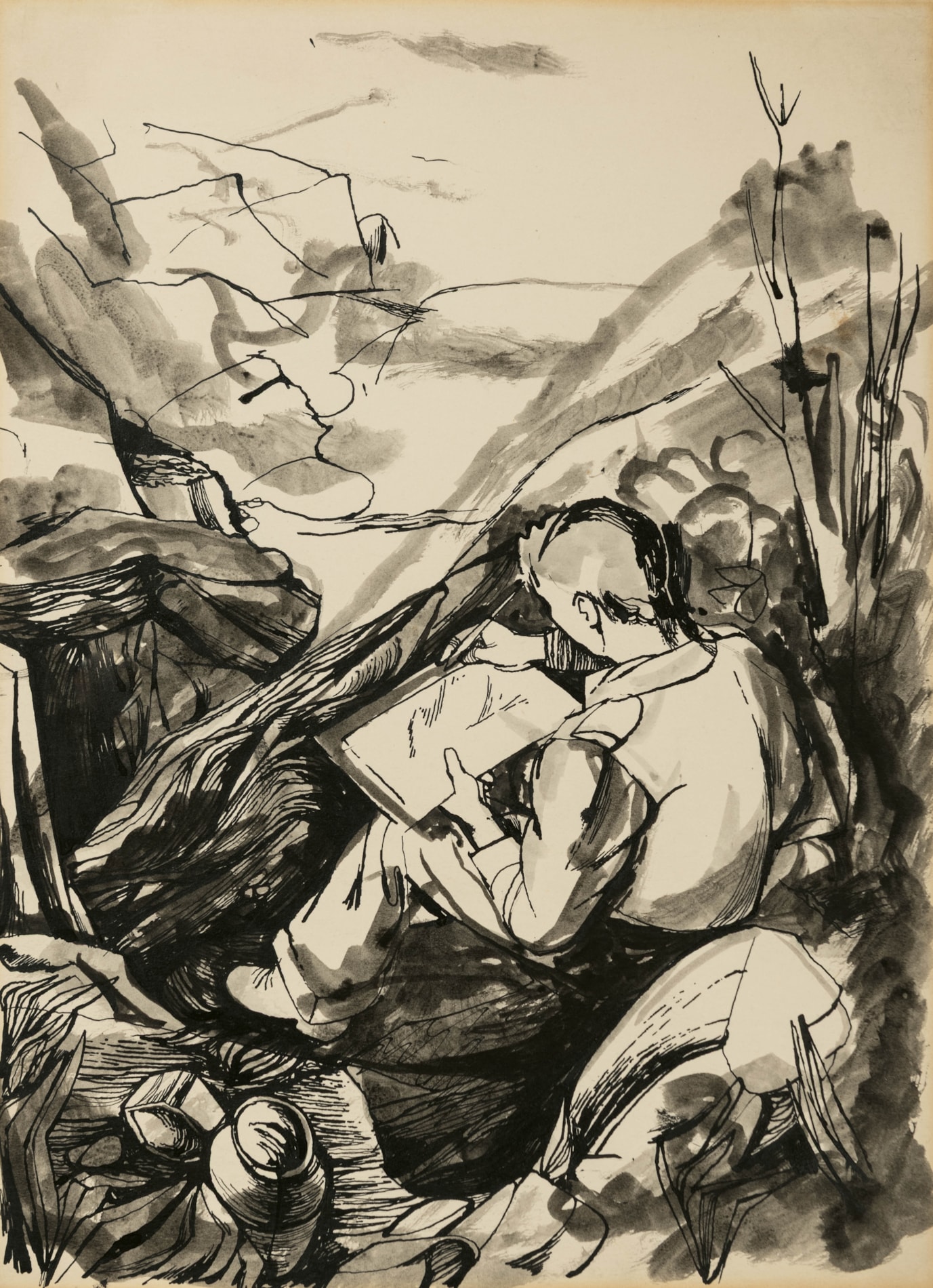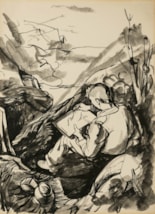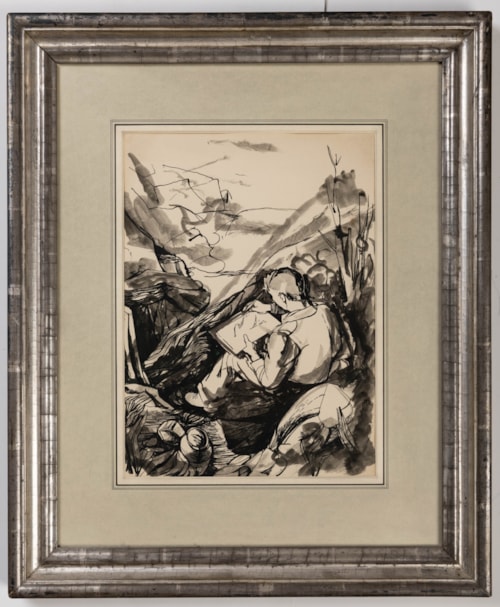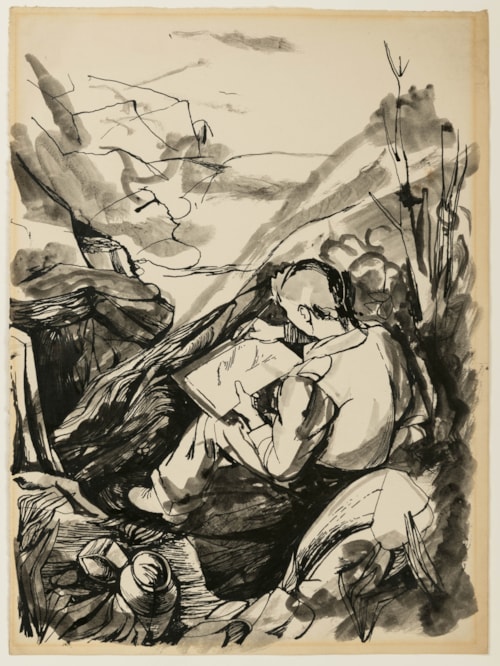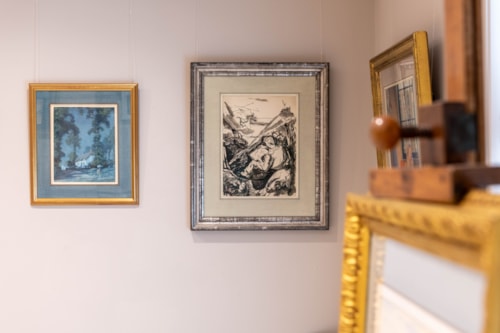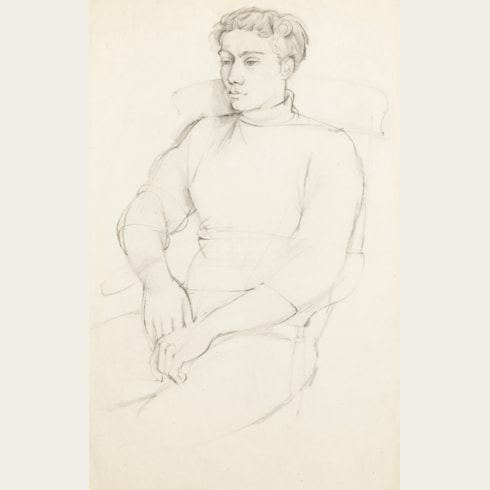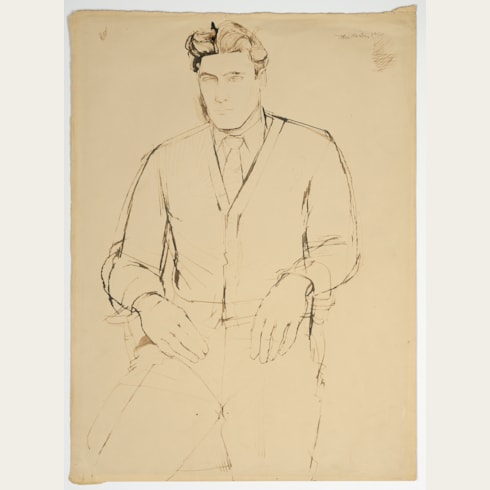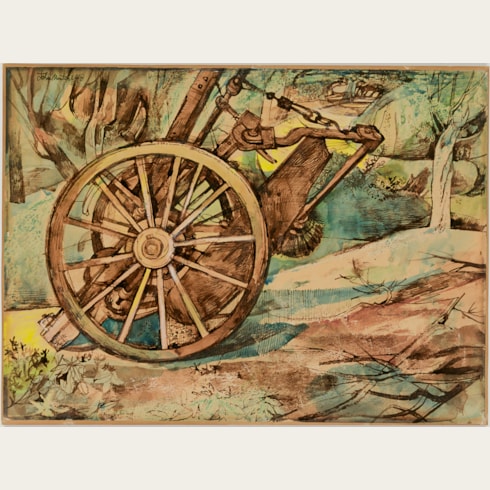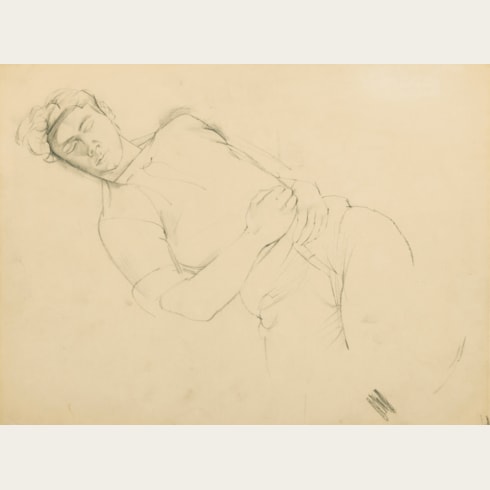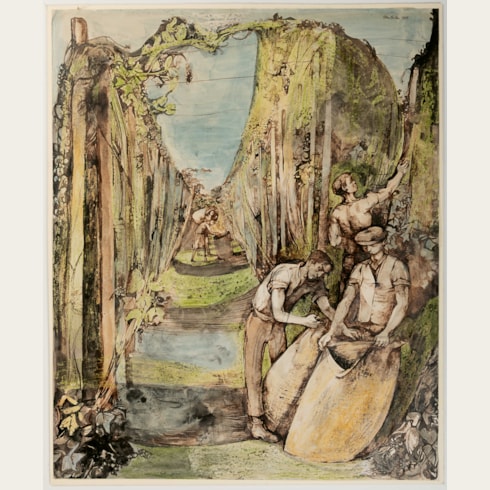John MINTON
(Great Shelford 1917 - London 1957)
An Artist Sketching in a Landscape
Pen and black ink and grey wash.
365 x 265 mm. (14 3/8 x 10 1/2 in.)
365 x 265 mm. (14 3/8 x 10 1/2 in.)
As John Minton’s biographer has written, ‘As a lyrical draughtsman, with the skill and dash of a latter-day Tiepolo, he produced a steady flow of illustrations, for books, magazines and advertisements, with a decorative talent second to none of his generation.’ The present sheet has been related to Minton’s illustrations for the travel book Time Was Away: A Notebook in Corsica, written by the poet Alan Ross and published in 1948, although this image does not appear in the book and may have been an unused drawing for the project. Certainly, the landscape in this drawing is akin to the monochrome illustrations in Time Was Away, as is the handling of the pen and ink medium. Time Was Away was commissioned by the publisher John Lehmann, who dispatched Minton and Ross to Corsica with instructions to travel around the island and ‘come back with a book’. The ninety-five illustrations that Minton produced represent arguably his finest work as an illustrator, and indeed Time Was Awayhas been described as ‘one of the most significant illustrated books of the twentieth century.’
Of Ross and Minton’s travels in Corsica, Frances Spalding has written that, ‘After the greyness of war-scarred London, tired, shabby and impoverished, the Mediterranean came as a sudden shock…The exuberance [Minton] felt is manifest in his drawings: rarely have topographical subjects been treated with such freedom and energy. The glaring light of high noon encouraged his use of rich blacks. These convey not only shadow but also heat, his suns gaining in intensity from a surrounding ring of black. His scenes are never static but animated by his fast-moving line and by his attention to the life of the place…Time Was Away opened up a whole new repertoire. Minton’s drawings do not simply illustrate Ross’s text but, in their breadth and vigour, enlarge upon it…Though Minton’s illustrations to an extent derive from the stock-in-trade ingredients used by topographical and Romantic artists, they yet compose an inventive and original style. Time Was Away became a cult book among illustration students.’
As one writer and collector has noted of the artist’s graphic work of the second half of the 1940s, ‘Minton’s use of solid areas of black in his illustrations, in particular for Time Was Away, was exceptionally skilful and powerful in its effect. The elegance of his pen and ink drawing gave the deceptive impression of being effortless…[Minton’s output] over those brief, heady post-war years has left us a body of graphic work that stands comparison with the best of British illustration. The very fragility of his draughtsmanship and quality of line, so assured and alive when he was at his best but falling away in his later years, contributes to the appeal that his work continues to hold.’
Of Ross and Minton’s travels in Corsica, Frances Spalding has written that, ‘After the greyness of war-scarred London, tired, shabby and impoverished, the Mediterranean came as a sudden shock…The exuberance [Minton] felt is manifest in his drawings: rarely have topographical subjects been treated with such freedom and energy. The glaring light of high noon encouraged his use of rich blacks. These convey not only shadow but also heat, his suns gaining in intensity from a surrounding ring of black. His scenes are never static but animated by his fast-moving line and by his attention to the life of the place…Time Was Away opened up a whole new repertoire. Minton’s drawings do not simply illustrate Ross’s text but, in their breadth and vigour, enlarge upon it…Though Minton’s illustrations to an extent derive from the stock-in-trade ingredients used by topographical and Romantic artists, they yet compose an inventive and original style. Time Was Away became a cult book among illustration students.’
As one writer and collector has noted of the artist’s graphic work of the second half of the 1940s, ‘Minton’s use of solid areas of black in his illustrations, in particular for Time Was Away, was exceptionally skilful and powerful in its effect. The elegance of his pen and ink drawing gave the deceptive impression of being effortless…[Minton’s output] over those brief, heady post-war years has left us a body of graphic work that stands comparison with the best of British illustration. The very fragility of his draughtsmanship and quality of line, so assured and alive when he was at his best but falling away in his later years, contributes to the appeal that his work continues to hold.’
Although he had only a relatively brief career before his death at the age of thirty-nine, John Minton was enormously prolific and achieved a great deal of success in his lifetime. Between 1945 and 1956 he had eight one-man shows, mainly at the Lefevre Gallery in London, as well as taking part in a number of group shows and the Royal Academy Summer exhibitions. Alongside his output as a painter and draughtsman, he provided numerous illustrations for books, book jackets, magazines and advertisements, and also designed posters, wallpaper and stage sets.
While he enjoyed considerable early success, by the 1950’s Minton’s work was becoming overshadowed by that of other artists in his circle, notably Lucian Freud and Francis Bacon. As a friend of his later wrote, ‘He saw himself as overtaken by fashions in art – abstract expressionism among others – for which he had no liking. While others of his contemporaries – Lucien Freud, Francis Bacon, Keith Vaughan - held their ground and came through, Minton saw himself as obsolete, as eccentric and old-fashioned as Edward Lear. He could not come to terms with new developments and he lost faith in his own talent…He was, I suppose, one of those kingfisher-like specimens whose bright plumage briefly glinted then was gone. It might, perhaps, have been different in other circumstances; a little more patience and he could have survived the disorienting shifts in taste.’
Minton devoted much of his later career to teaching, in particular at the Royal College of Art, and was a popular and inspirational figure among his students. As Frances Spalding has written of him, ‘Minton’s virtuoso performances with pencil or pen and ink commended him as a teacher. His students aspired to his dexterity and adopted his devices.’ Minton died, by his own hand, in January 1957.
Provenance
Possibly the Lefevre Gallery, London, in 1949
Anonymous sale, London, Christie’s South Kensington, 6 December 2007, lot 53
Private collection, London.
Anonymous sale, London, Christie’s South Kensington, 6 December 2007, lot 53
Private collection, London.
Literature
Possibly London, The Lefevre Gallery, New Paintings and Water Colours by John Minton, February 1949, no.57 (‘Boy Drawing’).

